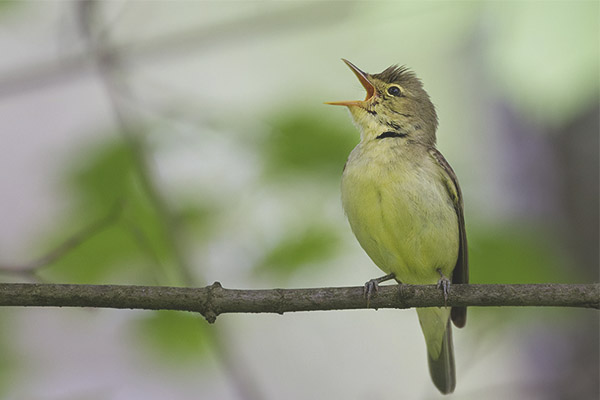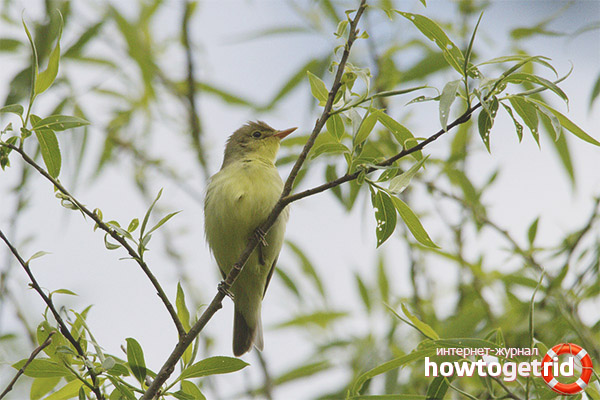The content of the article
By green peremeshka means small-sized bird, which in its external data is similar to the foam. The only thing is that mocking is partly different in coloring. Its upper part is pigmented brownish-green, and the lower part is yellow-green. At the same time in the area above the beak there is a shade of reed or light yellowness. The representative lives, preferably in the leafy area, in the canopy of the trees. Differs in mobility and interesting whistle. But we will not advance to reveal all the cards, we will focus on the characteristics in more detail.
Features of the form
- In terms of their external features, these birds are something between the warblers and warblers. They are slightly larger than the second representatives. They are famous for their short legs, elongated wings, which reach behind the tail and taper at the edges.
- The tail is trimmed in a straight line, but it can be elongated in some feathers. At the base decently expands.The head is large in format, the frontal part is high, the feathers on the parietal part are raised.
- Birds perch vertically like flycatchers. As for lifestyle, these individuals prefer to dwell on tall and thick shrubs, as well as in the crowns of deciduous trees. They live near elder, honeysuckle, etc.
- The specimens of the species discussed are famous for their mobility. They jump from place to place, wandering along the branches. Very often whistling during the flight.
- When they are engaged in gathering food, they can quickly fly and grab a future meal in flight. If there is no food in the place of residence, the birds gradually move to other places.
Description
- Individuals of this breed group are rather small. Their weight is only 15-18 grams. with a wingspan of 25 cm and a body length of 15 cm. Coloring consists mainly of yellow, green, brown tones.
- The top is beige with greens. A distinct yellowish pigment is visible below, it is especially clearly seen on the chest. On bends of wings bright yellow color is marked. Wings with tail pigmented green.
- When the wings are in the folded state, they can see bright areas. Feathers are framed by kayochochka and look expressive. The edges are thin and barely noticeable. Around the sockets there is a yellow edging. Above the beak spot of the same tone.
- The irises are brownish or dark in color. The area above the beak is dark. The legs are light, with shades ranging from brown to gray. In young male more loosened plumage. Virtually no yellow and green colors.
Spread
- The distribution of the individuals in question is truly amazing. Often they try to settle in mixed and deciduous forests. Also, birds can be found in the southern taiga, which is located in central Europe and stretches to Scandinavia and in the south-eastern part of Western Siberia.
- With the onset of cold weather, the birds in question are going to winter in southern Africa, closer to the equator. As for the European part of Russia, birds live here in the usual or few in number. In the middle lane, birds appear around May. Wintering is sent in early autumn.
Mating season
- The represented individuals are monogamous, therefore they choose their companions only once. Such birds reach sexual maturity at about 1 year. Therefore, after the birth of the next season, they are fully capable of giving birth.
- During the mating season, male individuals are bathed in beautiful trills. Males try to do this on the tops of the trees. It does not fly out of the crown, but it moves from branch to branch. The male can continue to sing even while moving.
- At this point, he spreads his wings wide and instantly lost among the leaves. If a male notices a man in the forest, he immediately stops his singing. The bird will fly several tens of meters and continue its trills.
- However, in settlements and busy squares birds do not hesitate to sing at all. They are not as careful as in the wild. Once the males are taken to divide the territory, they become very aggressive.
- Therefore, in spring, in any conflicts, one can often observe clashes among individuals, they fight with their beaks. In parallel, you can hear the characteristic click. Males also spread their wings wide to scare off a competitor.
Green mockery in the mating season are too aggressive. They even chase away other songbirds from their nests. Considered individuals often clash with competitors. As soon as mockingbirds find a mate, they calm down. Adults begin the joint construction of the nest.
Video: green peremeshka (Hippolais icterina)












To send